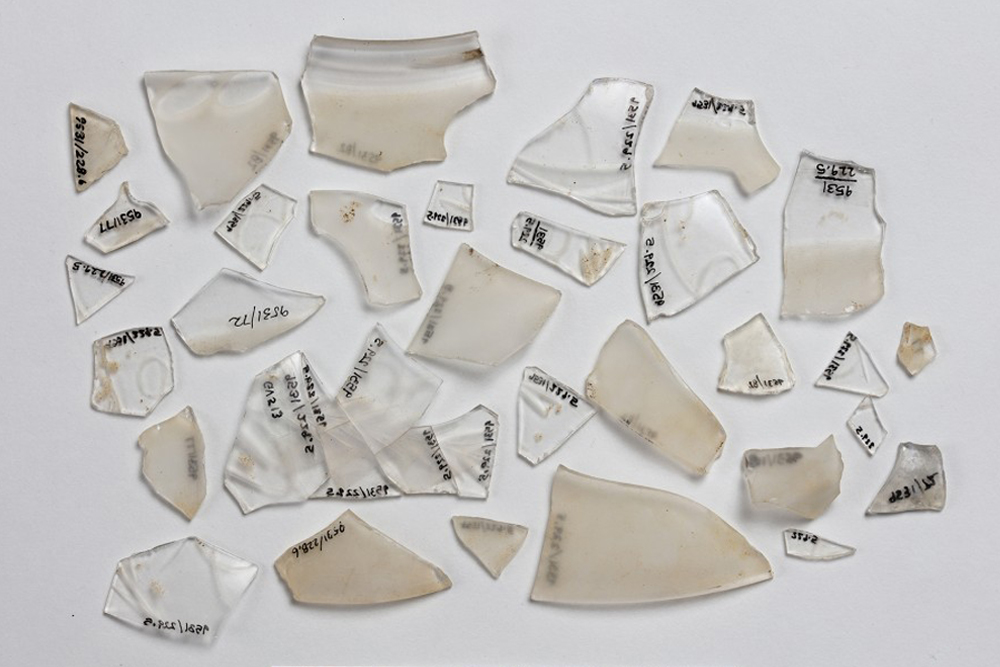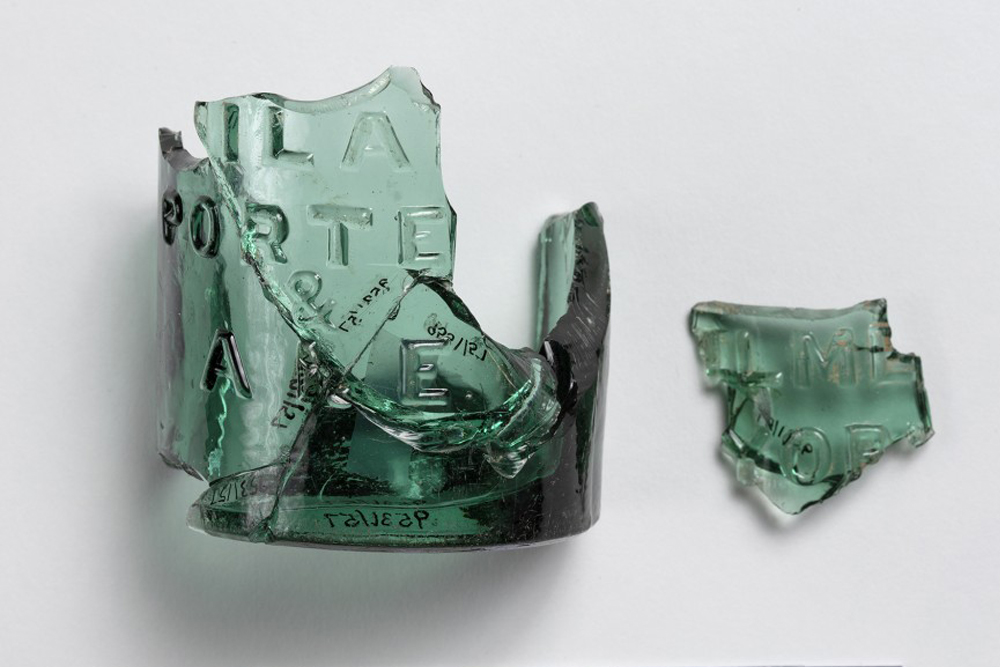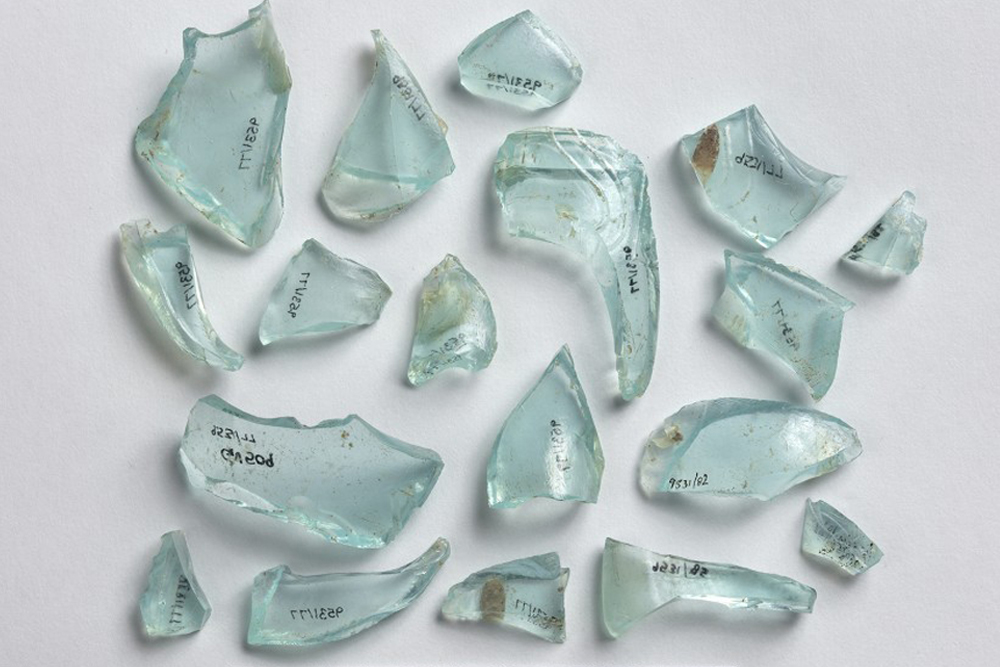Smoking pipe

Figure 1: A smoking pipe excavated from Seneca Village. (Photo courtesy of the NYC Archaeological Repository)
Background
My artifact is a ceramic pipe from the nineteenth century, most likely produced in the United States. The date of production is unknown, but I suspect it was produced around the mid-1800s because it was excavated from a buried ground surface at the Seneca Village site dating to 1857. Additionally, pipes like these were relatively inexpensive and fragile, and were thus used and discarded quickly (Bradley 2000). Pipes from this time period tend to be heavily decorated and this pipe is decorated with broad, regularly-spaced fluting, also called “gadroons” (Reckner and Dallal 2000, 8). The style probably originated in Central Europe, but spread throughout the Americas (Reckner 2000). During this time, France, Canada, the US, and the UK were all producing pipes, leading to a variety of styles around the world. Figure 2 is an example of a pipe with gadrooning recovered from the Five Points neighborhood.

Figure 2: A smoking pipe fragment from Five Points. (Reckner, Paul and Diane Dallal. 2000. Five Points: Working-Class Life in Nineteenth Century New York Volume VI: The Long and the Short, Being a Compendium of Eighteenth- and Nineteenth-Century Clay Tobacco Pipes from the Five Points Site, Block 160, New York City. West Chester, PA: John Milner Associates.)
Pipe Identification and Analysis
Most of the pipes like these recovered from archaeological sites are in fragments. It is difficult to date a pipe to a specific manufacturing period because pipes are rarely marked with a date; therefore, pipes need to be analyzed in multiple ways, including “stem bore diameter, stem thickness, and bowl size and shape”(Bradley 2000, 113). Maker’s marks are another method of dating pipes. Maker’s marks indicate the maker, which we can link to the place of manufacture. Unfortunately, this pipe does not have a maker’s mark.
Historical Context
Smoking pipes in nineteenth-century New York City were extremely commonplace, as smoking was considered an integral part of the social scene. One example of this is the working-class neighborhood of Five Points. According to archaeologists Paul Reckner and Diane Dallal, “virtually every depiction of Five Points, textual or visual, shared one element in common–the streets were peopled with men and women clenching tobacco pipes between their teeth,” as shown in Figure 3. (2000, i).
This indicates that tobacco use was extremely important in the social life of the working-class immigrant communities of the time. Tobacco and alcohol were not considered harmful during the late eighteenth and early nineteenth centuries. Today we know that nicotine is an appetite suppressant, which might have allowed laborers to work for extended periods of time with little food; “popular humoral and miasmic notions of health and illness held that alcoholic drinks strengthened the body and tobacco smoke cleansed the lungs and defended against disease bearing vapors” (Reckner, 1999, 66). By the middle of the nineteenth century, however, the middle class had begun to develop more negative views about tobacco use.

Figure 3. A drawing of a Five Points oyster bar. (Reckner, Paul and Diane Dallal. 2000. Five Points: Working-Class Life in Nineteenth Century New York Volume VI: The Long and the Short, Being a Compendium of Eighteenth- and Nineteenth-Century Clay Tobacco Pipes from the Five Points Site, Block 160, New York City. West Chester, PA: John Milner Associates.)
Tobacco and Etiquette
During the 1850s, etiquette guides were published that outlined appropriate use of tobacco and alcohol for the middle class. These guides particularly advocated against chewing tobacco; “spitting tobacco juice greatly offended middle-class Victorian sensibilities, as expectoration was felt to be a bodily function to be carried out, when absolutely necessary, in private.” These guides also advised against smoking, and especially against the use of tobacco by women (Reckner, 1999, 68).
Nevertheless, smoking remained common in public places in New York, even though by mid-century it was prohibited in some cities, such as Boston. Among the working class, saloons were socially acceptable locations for substance use, as saloons were “social and political centers for the [working-class] community and a place where neighborhood men typically gathered to celebrate, especially on nationalistic and political holidays” (Reckner, 1999, 64). Other recreational objects, such as a porter and ale bottle, corroborate the prevalence of smoking and drinking in nineteenth-century working-class culture. Excavations of middle-class households in Brooklyn show that this picture of smoking as only a working-class habit in 1850 is incomplete; archaeologist Robert Fitts uncovered multiple smoking pipes, suggesting at least some middle-class residents smoked at home (1999).
In Seneca Village
It was less common for women to use tobacco pipes, as it was seen as lewd and offensive and women were seen as moral guides for their husbands and children. It is likely that the father or older boys in the house would have regularly used the pipe for smoking tobacco. Reformers believed that alcohol and tobacco were bad influences for the poor citizens, which consisted mostly of Irish and German immigrants and African Americans. While substance use was acceptable in moderation, the poor were not seen as morally sound enough to exercise self-restraint and use tobacco and alcohol responsibly. This resulted in the working class rebelling against the expectations of the middle class by distancing themselves from those ideals. However many working-class people, including immigrants and African Americans, sought acceptance through conformity to these standards. In the case of Seneca Village and the Webster and Phillips households, multiple pipe fragments found on the properties indicate the likelihood of at least occasional smoking in the yard.
Works Cited
Bradley, Charles, S., 2000. “Smoking Pipes for the Archaeologist.” In Studies in Material Culture Research, edited by Karlis Karklins, 104–133. Tucson, AZ: The Society for Historical Archaeology.
Fitts, Robert K. 1999. “The Archaeology of Middle-Class Domesticity and Gentility in Brooklyn.” Historical Archaeology 33, no. 1: 39–62.
Reckner, Paul. 2004. “Home Rulers, Red Hands, and Radical Journalists: Clay Pipes and the Negotiation of Working-Class Irish/Irish American Identity in Late-Nineteenth-Century Paterson, New Jersey.” In Smoking and Culture: The Archaeology of Tobacco Pipes in Eastern North America, edited by Sean M. Rafferty and Rob Mann, 241–71. Knoxville, TN: University of Tennessee Press.
Reckner, Paul and Diane Dallal. 2000. Five Points: Working-Class Life in Nineteenth Century New York Volume VI: The Long and the Short, Being a Compendium of Eighteenth- and Nineteenth-Century Clay Tobacco Pipes from the Five Points Site, Block 160, New York City. West Chester, PA: John Milner.
Reckner, Paul, and Stephen A. Brighton. 1999. “‘Free from All Vicious Habits’: Archaeological Perspectives on Class Conflict and the Rhetoric of Temperance.” Historical Archaeology 33, no. 1: 63-86.




